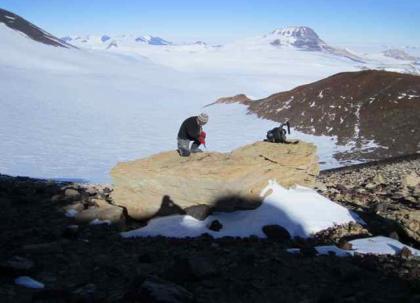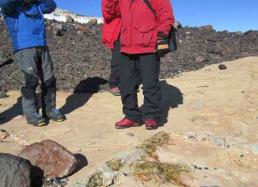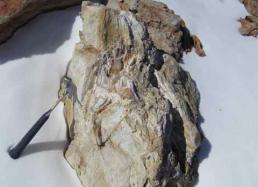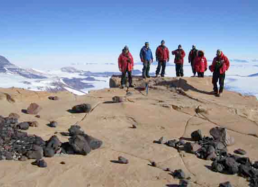7: A Fossil Forest at 12,000 Feet
On Tuesday, our team split into three different groups to cover several different objectives. The main party headed back to the Cryolophosaurus quarry to continue cleaning off debris, and to map out the three-dimensional positions of individual bones exposed in the quarry. This will help us to understand the site’s taphonomy (the process of decay that affected the animal and plant remains as they fossilized), and also make it easier to prepare the fossil blocks once they are back in Chicago and Rock Island.
Armed with a rock saw, Chris, Roger, and Adam headed back to Fremouw Peak to begin excavating their finds and to search the outcrop for more bones. Peter Braddock and myself headed to a large patch of outcrop on the southwest face of Mt. Kirkpatrick. This area was roughly the same elevation as the rocks present throughout the exposures near the Cryolophosaurus quarry, but it’s separated from them by a large field of loose volcanic rock debris and an hourglass-shaped ice patch. The area had never before been prospected for fossils, so we weren’t sure what we might find, but we knew that we’d be walking through rocks that spanned the same levels as those found at the main quarry.
Our helicopter landed on a flat patch of rock at the base of the exposure, around 11,500 ft. We started our way up the slope, and almost immediately Peter found an immense sandstone boulder that contained carbonized plant remains (see top photo). As we moved further uphill, we encountered more and more plant material like this, as well as some petrified logs. All of the fossils appeared to be coming from large, cliff-forming layers of cross-bedded sandstones.
At a break for lunch, we checked our elevation and the air temperature; just over 12,000 ft, and right around 3° F, although the pounding sun made it feel much warmer. Just after lunch, I thought I spotted an odd form weathering out of a large cliff of cross-bedded sandstone, separated above us by seven meters of hard ice. We kicked our boots in and cautiously headed up, with Peter shimmying along the ledge to take a closer look.
False alarm: just an odd clay nodule weathering out of the sandstone. I slowly traced my steps back down, but the top of the ice where Peter was standing looked a bit too sketchy (hard packed ice on a steep slope can turn a minor slip into a long and rapid descent). Peter instead vaulted over the top of the sandstone ledge, and we agreed to meet around the corner.
At our meeting point to the north, where the rock exposure abuts a sloping layer of loose volcanic rock debris, we made an exciting find: a pile of large petrified tree stumps, once again found within large chunks of cross-bedded sandstone (see Photo #1 below). The most massive of these stumps occupied almost the entirety of a three-foot cubed boulder. Clearly defined rings of annual growth could be seen in some of the partially weathered cross sections of the stump, and individual roots could be distinguished branching out from its base (see Photo #2 below).
Based on our elevation and the rock units we were walking through, we were still in the lower portion of the Hanson Formation, the same unit that contains Cryolophosaurus. Very little fossil wood has been collected or described from this high in the section, so our new plant fossils should prove to be very valuable scientifically.
After collecting some of the smaller chunks of fossil wood, we headed back down slope to our original helicopter landing site. On our way down, we could see more patches of outcrop approximately 1,000 ft. below the main landing site, past a long pile of loose rock debris. There was enough time left to make it there to prospect, but not enough to come back, so we needed to get in touch with the helicopter pilot to arrange an alternate pick-up site.
We'd been having trouble with our radio all day and were only receiving broken messages through Mt. Falla’s repeater (the instrument that can relay signals between radios that are not within the line of sight). Fortunately, when the helicopter came in to pick up the first group from the Cryolophosaurus quarry higher up (see Photo #3), we were able to contact him directly on another channel and arranged to be picked up at a new, lower site.
When we reached the lower outcrops, we found they were essentially barren of fossils, and most had large intrusions of igneous rock within them. However, we did find a nice half-meter-thick coal bed just below the base of the sandstone layers, so we managed to take a few samples.
At this point, we got some bad news on our spastic radio: while the second part of our team was being picked up from the dinosaur site, the other helicopter had a minor hydraulics problem. Although it was able to set down safely, it would take awhile for its passengers to be ferried back to camp with the other helicopter, and even longer for mechanics from camp to come out and check on the issue.
We and a few other science groups still out in the field were told not to expect a pickup until 11 p.m., which, depending on the mechanical issue, meant that we might have to stay overnight at our site. This entailed a long, slow hike back up 1,000 vertical feet of volcanic debris to our survival bag at the original landing spot.
Fortunately, at only about halfway up (at approximately 11,000 ft), we received a clear message on our annoyingly crappy radio: the problem was fixed, and both helicopters were ferrying teams back to camp. We could expect a pickup around 10:30 p.m. Thankful that we didn’t have to trudge for another hour uphill, or spend the night, we headed back down to the lower landing site. When the helicopter came around the valley, Peter gave a couple of quick flashes with a signal mirror to help them locate us, and we were back in camp by 11:00 p.m—met by a warm dinner that the camp chef had selflessly stayed late to make for us and a few others.
Unfortunately, the delays pushed everything on the schedule back far enough that one science team had to stay out overnight at their field site before being picked up in the morning. Although it was a relatively warm night with calm weather, it was a clear reminder of how important the survival bags and other equipment are out here. Even a minor problem can quickly snowball and change your evening’s plans. It’s certainly comforting to know that we have such well-trained and prepared camp staff and flight crews here, who are constantly working hard to keep everyone safe.
More soon,
Nate







